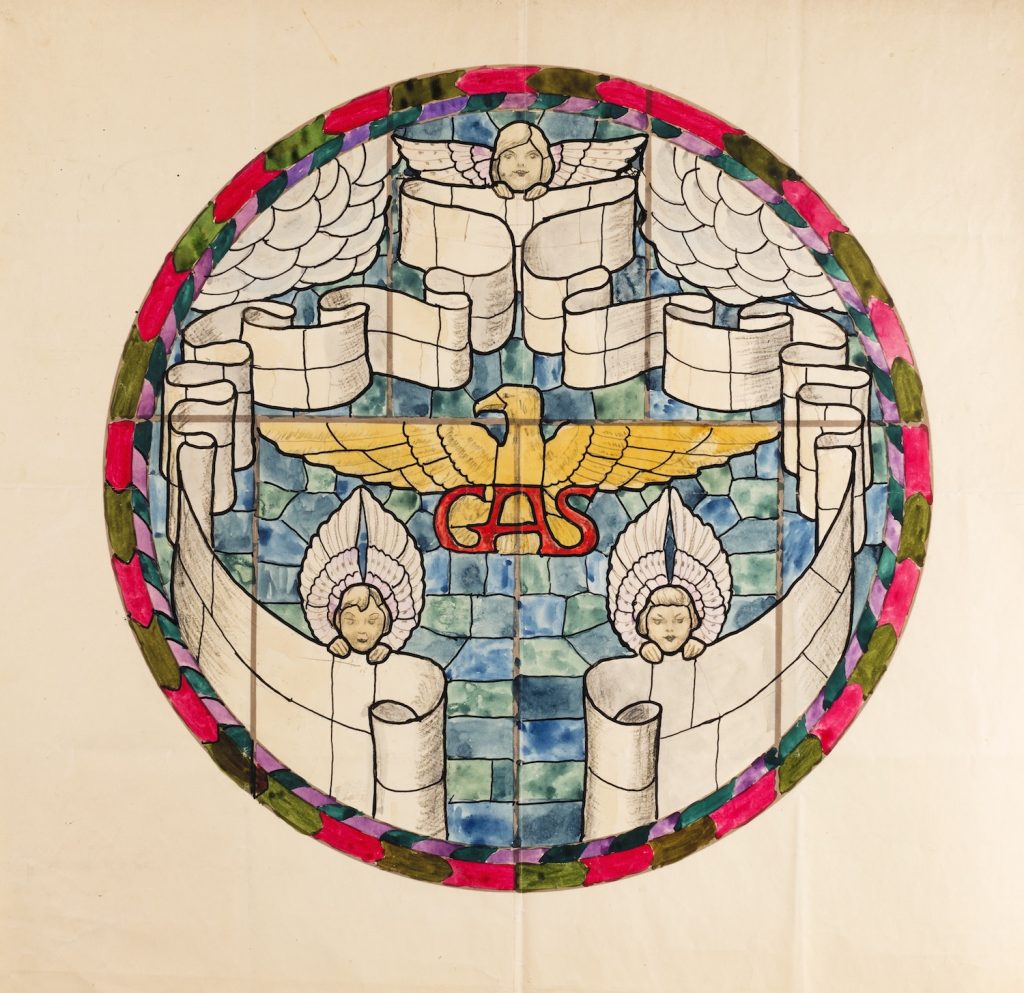Eric O. W. Ehrström’s sketch for the stained-glass window of organ balcony at Mänttä church
OCTOBER 2018
Mänttä church celebrated its 90th anniversary this autumn. Artist Eric O. W. Ehrström designed a round window with a stained-glass painting. It is located on the organ balcony. From outside, one can see it above the main entrance of the church. The sketch of the stained-glass painting belongs to the entity Eric and Olga Ehrström bequeathed to Gösta Serlachius Fine Arts Foundation. The bequest comprises paintings, sketches, print works, jewellery and other valuable objects.
The inauguration celebrations of Mänttä church took place on 15 September 1928 as part of the festivities related to G. A. Serlachius Company’s 60th anniversary. G. A. Serlachius Company had been responsible for the construction of the church and costs of the project. Architect W. G. Palmqvist had designed the church in cooperation with Gösta Serlachius. Serlachius had certainly contributed to decision-making concerning the major outlines as well as the smallest details.
In 1920s, churches were designed as unique total artworks. Therefore, the implementation of the interior’s details were usually placed in hands of professionals of visual arts. This was also the case for Mänttä church. Alwar Cawén designed the altarpiece and stained-glass paintings on the altar, whereas Hanne Autere created the magnificent wood reliefs. Gösta Serlachius commissioned his friend, virtuoso of art and design, Eric O. W. Ehrström to design the stained-glass painting of the organ balcony.
In the middle of the lead glass work, on the blue background, stands the logo of G. A. Serlachius Company. It had covered the cost of the construction: an eagle spreading its wings, and underneath it, in red letters, an abbreviation of the name of the company “GAS”. A white draped bundle of paper surrounds the eagle. The bundle of paper symbolises the paper that the Mänttä mills manufactured. Its merchandise had contributed to the funds of the company that had paid for the construction of the church. The only biblical references in the stained-glass painting remain the three little angels holding the bundle of paper. Red-green and blue-violet framing border the sketch.
It was not absolutely clear weather the stained-glass painting would be completed and delivered in time at the church before the inauguration ceremony. Just little over two weeks before the ceremony, Gösta Serlachius send a letter to Eric O. W. Ehrström stating that the church was almost completed already. However, “with deep sadness in his soul” he had to notify that the stained glass of the organ balcony was still missing.
Gösta Serlachius also requested Ehrström to let know immediately when he could deliver the stained-glass. To make the message more effective, Gösta Serlachius ended the letter stating that he was reluctant to leave the church unfinished. Moreover, he would suffer the most, if in fact Eric O. W. Ehrström were to be held accountable for the church not being completed.
Gösta Serlachius’ concern for the completion of the church is understandable. It was G. A. Serlachius Company who had urged the establishment of Mänttä congregation. In addition, it had promised to build the church for the congregation, which should have been completed already by May 1925. Due to company’s financial difficulties, the Finnish Government had decided to give three years extra time for the construction. In conclusion, Gösta Serlachius’ letter to Eric O. W. Ehrström had obviously had the intended result, since during the inauguration of the church, the glass painting was on its place on the organ balcony.
The implementation of the stained-glass painting designed by Eric O. W. Ehrström was subcontracted to S. Wuorio’s painting shop in Helsinki. This was the case with most of the stained-glass paintings of the 1920s and 1930s. Majority of the glass painting of the era were implemented specifically in churches. The motif of Ehrström’s glass painting for Mänttä church, however, is different compared to other ecclesiastic glass paintings of that time. Ehrström’s glass painting can be interpreted as a memorial tablet or sign of the constructor whereas the others were expressly ecclesiastical. So, the people of Mänttä were protected under the eagle’s wings dedicated to the company even when entering the Sunday mass.
Iida Luukkonen
Archive assistant
Sources:
Gösta Serlachius’ letter archive, Serlachius Museums, archival collection.
Knapas, Marja Terttu. Suomalaista kirkkoarkkitehtuuria 1917–1970 (2006).
Koivisto, Kaisa. ”Perinteen tuntua 1920- ja 1930-luvun kirkoissa”. Teoksessa Suomalaisia lasimaalauksia (2006).
Mönkkönen, Mauri. Mäntän historia 1860–1947 (1992).
Tarjanne, Hilla. S. Wuorio. Helsinkiläinen koristemaalausliike. (1998)


